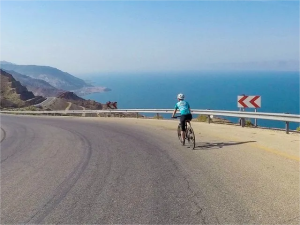The Glacial Erratics of Calgary
- by Mohamed Adam

Calgary, Alberta, Canada has a feature which is rather unique – glacial erratics. Several of these ice age mementos of various sizes are located within the Calgary city limits. Each of the glacial erratics of Calgary, although different in size and shape, are similar in rock type and origin.
THE ORIGIN OF THE FOOTHILLS GLACIAL ERRATICS
Some 15,000 to 20,000 years ago a rockfall occurred in the Tonquin Valley near Jasper, Alberta. The rock debris from this rockfall fell onto the massive glacier below and began a long journey from the Tonquin Valley, then out of the mountains as part of the Cordilleran Ice Sheet.
Contact with the larger Laurentide Ice Sheet deflected the rock debris along a southeast direction paralleling the front of the Canadian Rockies. Thousands of glacial erratic rocks were deposited along a 650 kilometres (400 miles) path from Hinton, Alberta to northern Montana, USA.
Unveiling Calgary’s Glacial Drift: A Journey Through Time and Ice
Calgary, a vibrant city nestled in the foothills of Alberta’s Rocky Mountains, is renowned for its stunning landscapes, bustling urban life, and rich cultural heritage. Yet, beneath its modern facade lies a geological story sculpted by the forces of nature over millennia. One of the most fascinating aspects of Calgary’s natural history is its glacial drift, a remnant of the powerful ice ages that once shaped the region.
What is Glacial Drift?
Glacial drift refers to the sediments and rocks that were transported and deposited by glaciers during the ice ages. This term encompasses both “till”—materials directly deposited by the ice—and “outwash,” which is sediment carried away by meltwater. In Calgary’s case, glacial drift is a testament to the immense power of ice sheets that once covered vast portions of North America, leaving behind a landscape marked by their frozen passage.
The Ice Age Influence
During the last Ice Age, known as the Pleistocene epoch, massive glaciers extended across much of North America. The Laurentide Ice Sheet, one of the primary ice sheets during this period, reached as far south as Calgary. As these glaciers advanced, they carved and shaped the landscape, grinding down mountains, filling valleys, and depositing vast amounts of sediment.
Calgary’s location at the edge of the Laurentide Ice Sheet means that its landscape bears the clear imprint of glacial activity. The ice sheet’s movement over the area left behind a diverse range of glacial drift, including moraines, drumlins, and outwash plains.
Key Features of Calgary’s Glacial Drift
Moraines: These are accumulations of glacial debris, including rocks, soil, and boulders, that were carried along by the ice and deposited at its edges. Calgary is surrounded by several moraine systems, which serve as natural markers of the glacier’s former extent. The Bearspaw and Glenmore moraines are prominent examples, creating ridges and rolling hills in the Calgary region.
Drumlins: These are streamlined hills formed by the action of glacial ice. Drumlins are typically elongated and parallel to the direction of the ice flow. In Calgary, drumlins are less conspicuous but still present, adding subtle but significant undulations to the terrain.
Outwash Plains: As glaciers melted, they released meltwater that carried away sediments, creating broad, flat plains known as outwash plains. The Calgary area features several outwash plains, which are crucial for understanding the sedimentary history of the region and the role of glacial meltwater in shaping the land.
Erratics: These are large boulders that were transported by glacial ice and deposited far from their source. Erratics are often found scattered across Calgary and serve as geological clues to the extent and movement of ancient glaciers.
The Impact on Modern Calgary
The glacial drift has played a significant role in shaping Calgary’s geography and influencing its development. The fertile soils left behind by glacial outwash plains are ideal for agriculture, contributing to the region’s farming success. Additionally, the varied terrain created by moraines and drumlins has influenced urban planning and infrastructure development.
Moreover, the natural beauty of the glacial landscape attracts outdoor enthusiasts and geologists alike. Calgary’s proximity to the Rocky Mountains and its glacial features provide ample opportunities for hiking, exploration, and study, connecting residents and visitors to the ancient forces that shaped the land.
Exploring the Glacial Legacy
For those interested in exploring Calgary’s glacial legacy, there are several key areas to visit. The Calgary area’s parks and natural reserves, such as Fish Creek Provincial Park and Nose Hill Park, offer opportunities to observe glacial features and enjoy the rugged beauty of the landscape. Additionally, local museums and geological societies often feature exhibits and information about the region’s glacial history.
In conclusion, Calgary’s glacial drift is more than just a geological curiosity; it is a window into the powerful forces that shaped the land we live on today. From the rolling moraines to the scattered erratics, these glacial remnants tell a story of ice and time, providing insight into the natural processes that continue to influence the region’s landscape and character. Whether you are a resident or a visitor, taking the time to understand and appreciate Calgary’s glacial heritage adds depth to the experience of this dynamic and beautiful city.
Calgary, Alberta, Canada has a feature which is rather unique – glacial erratics. Several of these ice age mementos of various sizes are located within the Calgary city limits. Each of the glacial erratics of Calgary, although different in size and shape, are similar in rock type and origin. THE ORIGIN OF THE FOOTHILLS GLACIAL…




